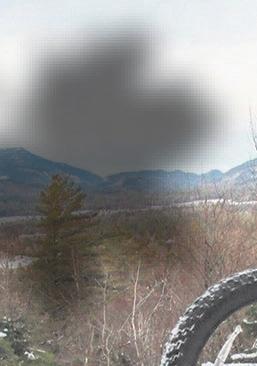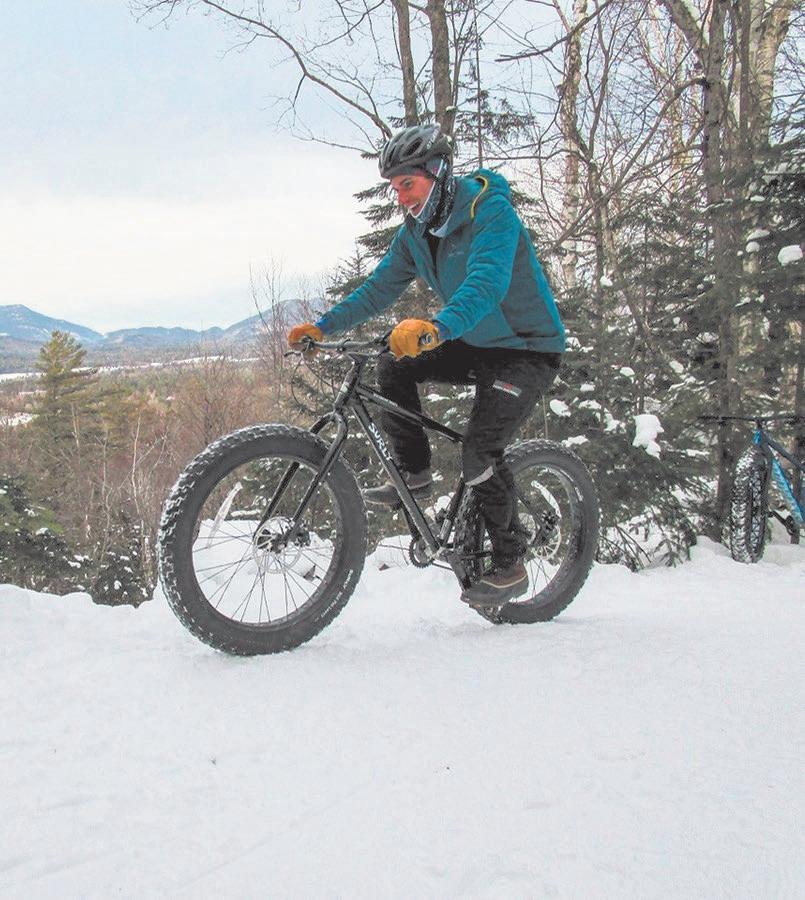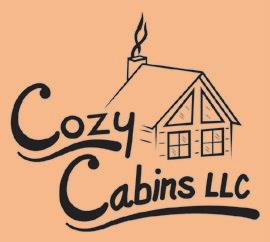
























With the leaves starting to change colors, it’s a perfect time to go hiking — or even paddling — and enjoy the scenic views this area has to offer.
If hiking or paddling isn’t your forte, then there are some other outdoor actives that you may want to try.
In this edition of EMBARK, we hope to give you some fun ideas or maybe even teach you about some new information you didn’t know about.
This season, we have a story about how loon parents regain their social skills as their kids grow up.
Or if you’re on the adventerous side we have stories about mountain biking, some information about small game hunting and even a personal viewpoint of both phases of the Adirondack Rail Trial.
We’d love your feedback. Send it to Embark, P.O. Box 318, Saranac Lake, NY 12983 or sports@ adirondackdailyenterprise.com.
Get up and get out!
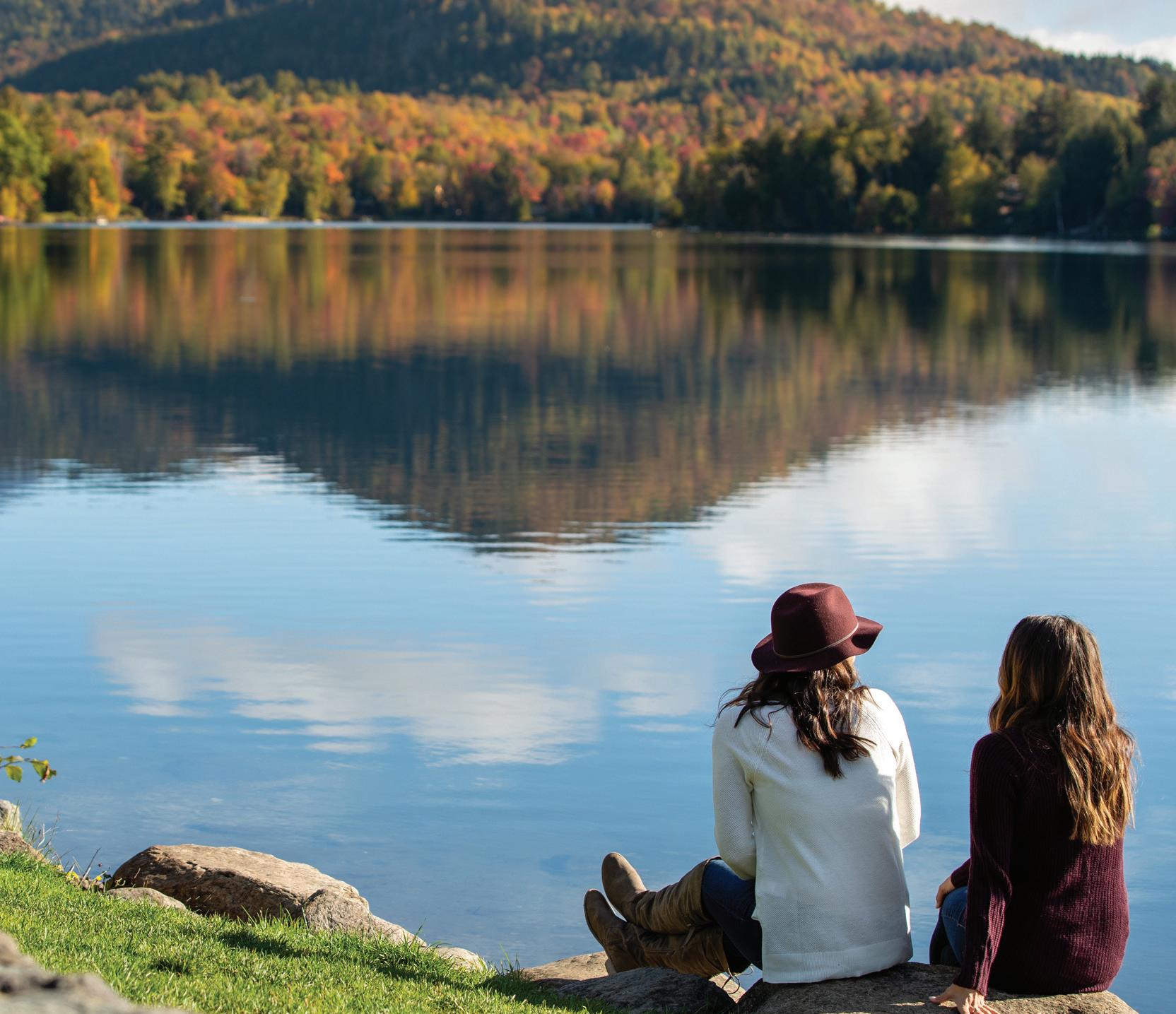



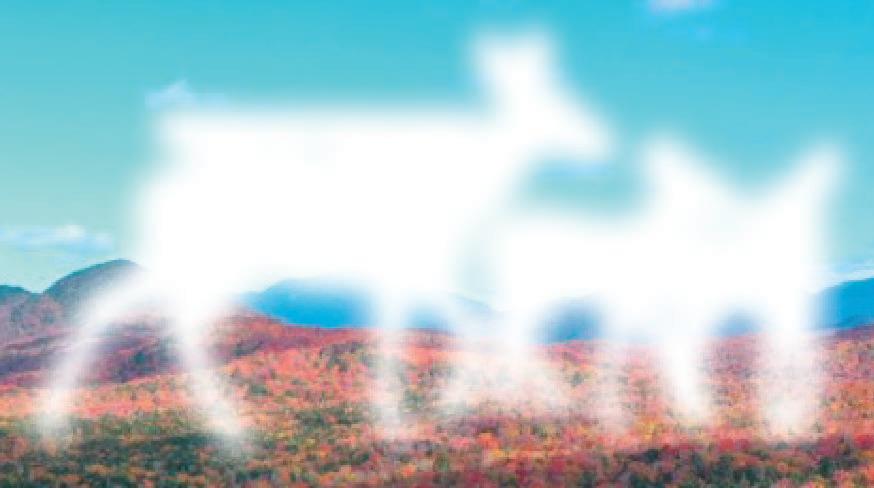





By PARKER O’BRIEN Sports Editor
WILMINGTON — As UCI Mountain Bike World Series descends onto the Lake Placid area in September, mountain biking as a whole is sure to see an increase in popularity.
While the UCI Mountain Bike Course at Mount Van Hoevenberg won’t be open to the public for use anytime soon, there are plenty of places in this area for you to take your mountain bike. In last season’s edition, we listed off some of the trails in Lake Placid, Saranac Lake and Tupper Lake. In this story, we figured we’d show some trails in Wilmington and Elizabethtown.
Below are just some of the trails to enjoy this fall.
Wilmington
To some the Wilmington area is regarded as the “mountain biking capital of the Adirondacks,” and it’s safe to say that title is a perfect fit. Wilmington has hosted numerous mountain biking races at Whiteface, including the Wilmington-Whiteface 100K and 50K, and next year
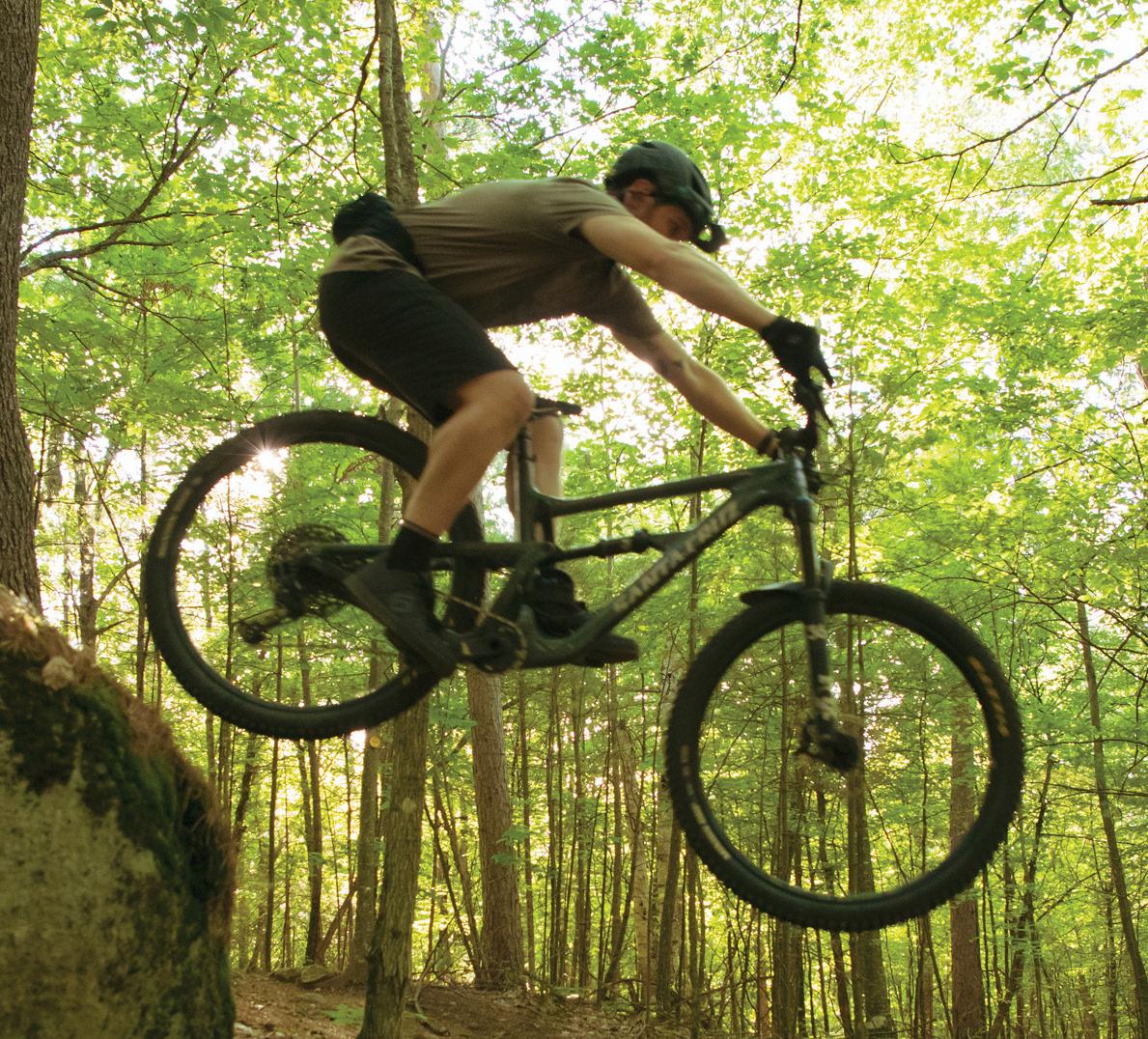
the site will be used for the UCI Mountain Biking Series Downhill race.
Below are some popular trails in Wilmington.
Flume Trails: This trail network is the original mountain bike destination in the Adirondacks’ Whiteface Region. The lower trails are smooth and flow-
ing. Riders gain elevation on the shoulder of Marble Mountain and the terrain becomes increasingly technical. The trailhead is located 2 miles south of the village center (Four Corners) on state Route 86, just across the bridge from the Hungry Trout Resort. Overflow parking is located just north of the main
parking lot on the opposite side of the road.
Hardy Road (Beaver Brook): This trail system was the first mountain bike specific trail system built in the Adirondack Park. The trails traverse both sides of the picturesque Beaver Brook Valley. The valley lies in a rain shadow of Whiteface Mountain and is typically much warmer and drier than surrounding areas. This makes it one of the most popular spots in the region when other trails are too wet to ride. To reach the trail, you’ll need to make your way to the intersection of Route 86 and Route 431 — also known as Whiteface Memorial Highway — and follow Route 86 toward Jay. Head straight for about 2 miles until you see Hardy Road on the right. Follow that road for another 2 miles, and you’ll see the trail system on the left. The Hardy Road trail network can also be accessed from the Wilmington Youth Park in downtown Wilmington through the Nor-
Continued on page 5
eens Trail and the Three Sisters Trail.
Three Sisters (Quaker Mountain): These trails are smooth and flowy with berms, rollers and optional jumps. Both Three Sisters Trail and Town Connector Trail are not only beginner friendly, but they’re a nice mix of fun for everyone. The Three Sisters Preserve can be accessed through trailheads at Quaker Mountain Road, Hardy Road or the Wilmington Youth Park, which is directly behind the Little Supermarket grocery store on Route 86.
Otis Mountain: This trail system is a 1940’s ski hill that has evolved into a challenging mountain bike, ski and trail running destination. This area consists of over 600 acres of privately owned land and includes several summits, views of the Giant Range, a waterfall and a large heron rookery on the property. The trails range in difficulty from lowland cruisers to technical, challenging climbs, as well as natural and man-made
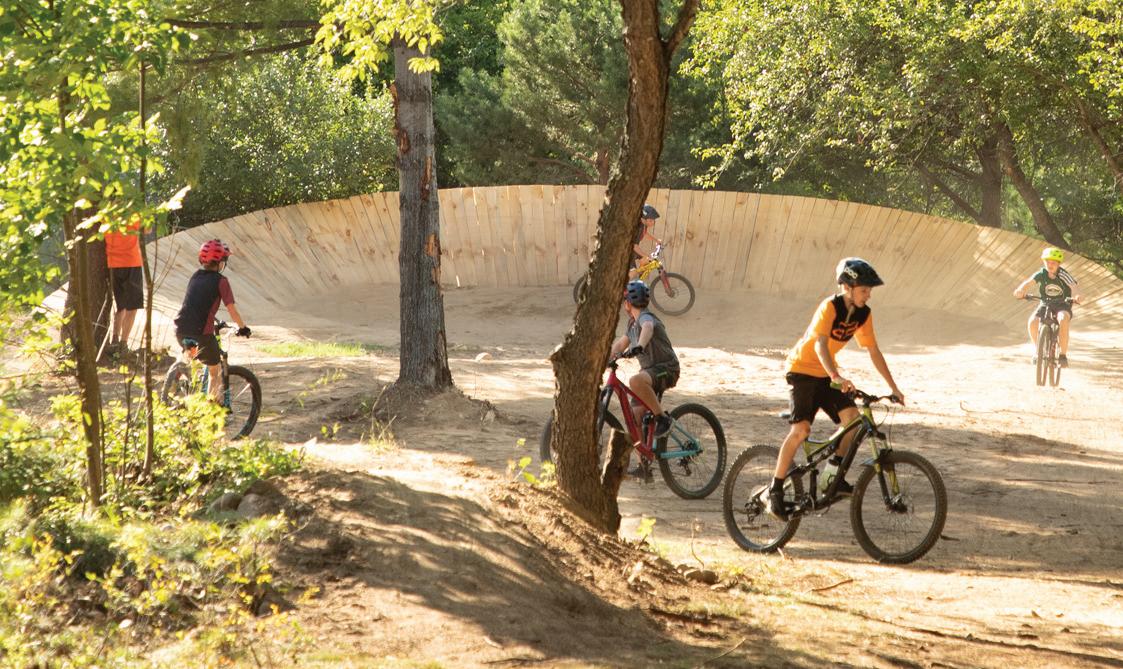
features. The trail is located about 2 miles south of Elizabethtown on Route 9. To find it, you’ll need to turn left onto Lobdell Lane, which is a dirt road. The parking area for trail access is just outside the entrance gate at the end of Lobdell Lane.
Blueberry Hill: This trail system is a network of multi-use trails spread over 900 acres of town-owned property. The trails are a perfect balance of wide and
rolling double track intertwined with technical and sometimes challenging single track. There are about 12 miles of trails linking three open summits with views of the Giant Mountain Wilderness, Lake Champlain and Vermont’s Green Mountains. To reach the trailhead from Route 9N just outside of Elizabethtown on the west side (toward Keene), turn onto Lord Road. A parking area and trail-
head are located 0.1 miles on the left side of Lord Road. Continue on Lord Road and take the first left onto Roscoe Road, then take the next left onto Bronson Way — a dirt road that starts between a house and a horse barn. Follow Bronson Way to a large sandlot parking area less than 0.5 miles on the right.
For more information on mountain bike trails, visit betatrails.org.
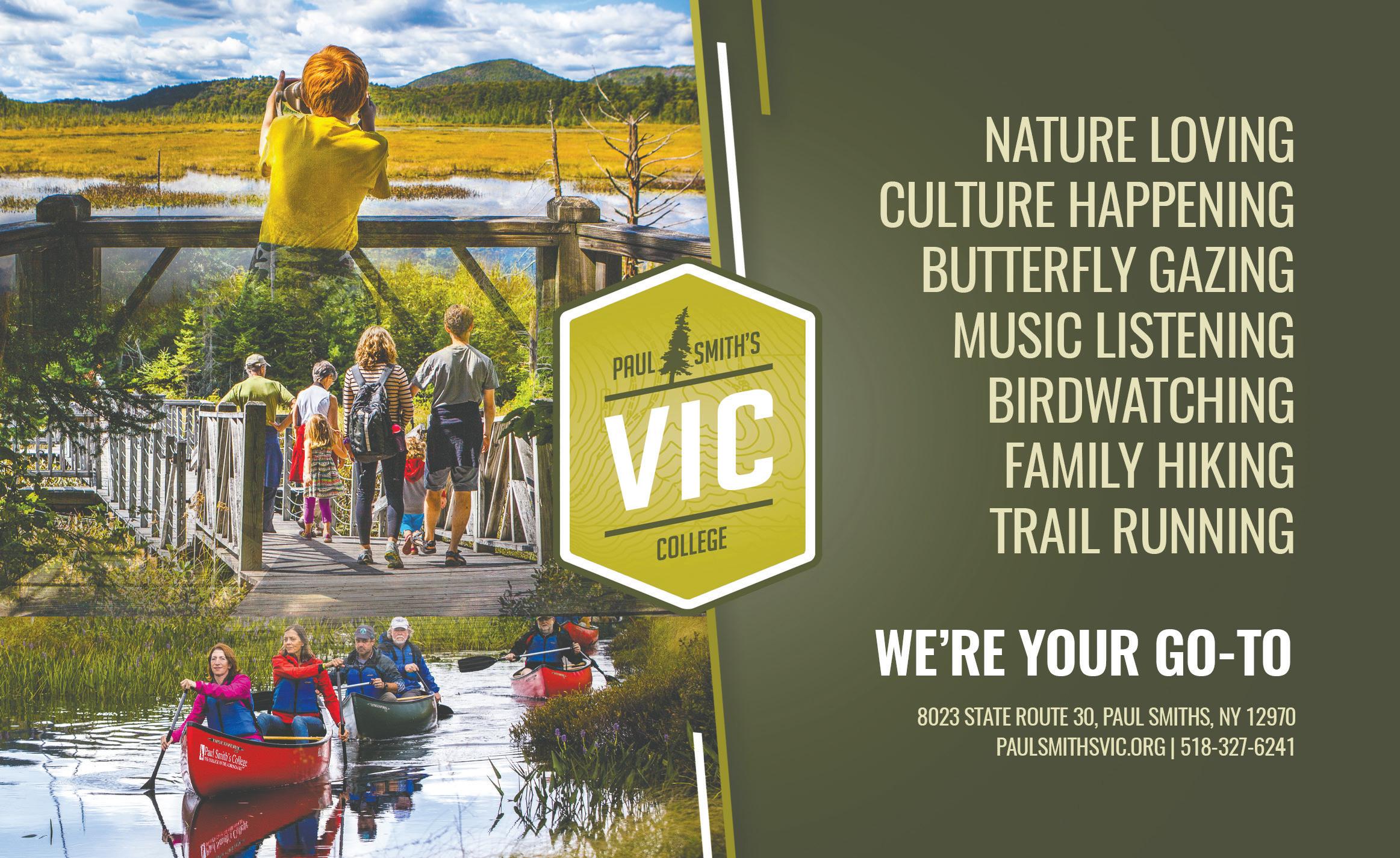

LAKE PLACID — As the leaves changes colors during the fall season, there are plenty of picturesque spots in the Adirondacks, and there might not be a better way to take in what the outdoors has to offer than with a hike, especially in Lake Placid.
The village offers its own hiking excursion, called the Lake Placid 9’er hiking challenge, where participants can attempt all nine hikes to earn a patch.
Once completed, download the registration form at https://lakeplacid9er.com and mail it with a $15.00 registration fee to: Lake Placid 9’er, P.O. Box 1310, Lake Placid, NY 12946. Make checks out to “Lake Placid 9’er.” Each finisher will be sent an official Lake Placid 9’er patch, sticker and registration number. Allow two to three weeks for processing. Download a free Lake Placid 9’er map from MR Maps at https://lakeplacid9er.com.
Cobble Hill, Lake Placid: 2.2 miles round-trip, 2,332 feet elevation Trailhead: From Lake Placid, follow Route 86 toward center of town. Take right at town hall onto Mirror Lake Drive. Follow past Northwood Road to entrance of Northwood School. Trailhead is 200 yards on left.
Mount Jo, Lake Placid: 2.6 miles round-trip, 2,876 feet elevation Trailhead: From Lake Placid, go east on state Route
Continued on page 7


Continued from page 6
73 to Adirondack Loj Road. Parking lot is at High Peaks Information Center. There is a $10/day parking fee.
Baxter Mountain, Keene: 2.4 miles round-trip, 2,440 feet elevation Trailhead: From Lake Placid, take state Route 73 west past Keene. Take left on Route 9N toward Elizabethtown. Continue about 2 miles to the top of hill. Trailhead is on the right.
Mount Van Hoevenberg, Lake Placid: 4.4 miles roundtrip, 2,940 feet elevation Trailhead: From Lake Placid, take
state Route 73 east to Adirondack Loj Road. After 4 miles, take left on Meadow Lane. Trailhead is 0.25 miles on left.
New Mount Van Hoevenberg “East Trail” begins at the Olympic Sports Complex off state Route 73.
Big Crow Mountain, Keene: 1.4 miles round-trip, 2,815 feet elevation Trailhead: From Lake Placid, take state Route 73 east. At 200 yards past the intersection with Route 9N in Keene, turn left on Hurricane Road at Keene Town Hall. At just over 2 miles, bear left on O’Toole Lane for 1.2 miles to end at Crow Clearing. Trail is on left.




Bear Den Mountain, Wilmington: 4.5 miles round-trip, 2,650 feet elevation Trailhead: From Lake Placid, follow state Route 86 to Whiteface Mountain Ski Center. Turn left into center. Follow road around to the right and the Bear Den Lot. Pitchoff Mountain, Lake Placid: 5.2 miles roundtrip, 3,500 feet elevation Trailhead: From Lake Placid, take state Route 73 to the Pitchoff West Trail, 7.5 miles. Pitchoff East Trail is 2.7 miles farther on Route 73. Trailhead is on left, parking on right.
Catamount Mountain, Wilmington: 3.6 miles round-
trip, 3,169 feet elevation Trailhead: From Wilmington, take Whiteface Veterans’ Memorial Highway. Just before the toll house, bear right toward Franklin Falls. Continue 3.3 miles to Roseman Road. Take a right. Follow Roseman Road for 0.8 mile. Turn right on Plank Road. Follow 2.2 miles to parking area on left.
Hurricane Mountain, Keene: 6.8 miles round-trip, 3,678 feet elevation Trailhead: From Lake Placid, take state Route 73 past Keene. Turn left on Route 9N after 15.5 miles. Parking area is 3.5 miles on right. Trailhead is on left.

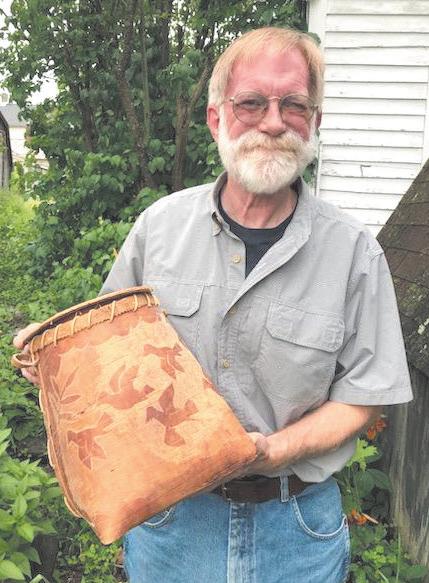






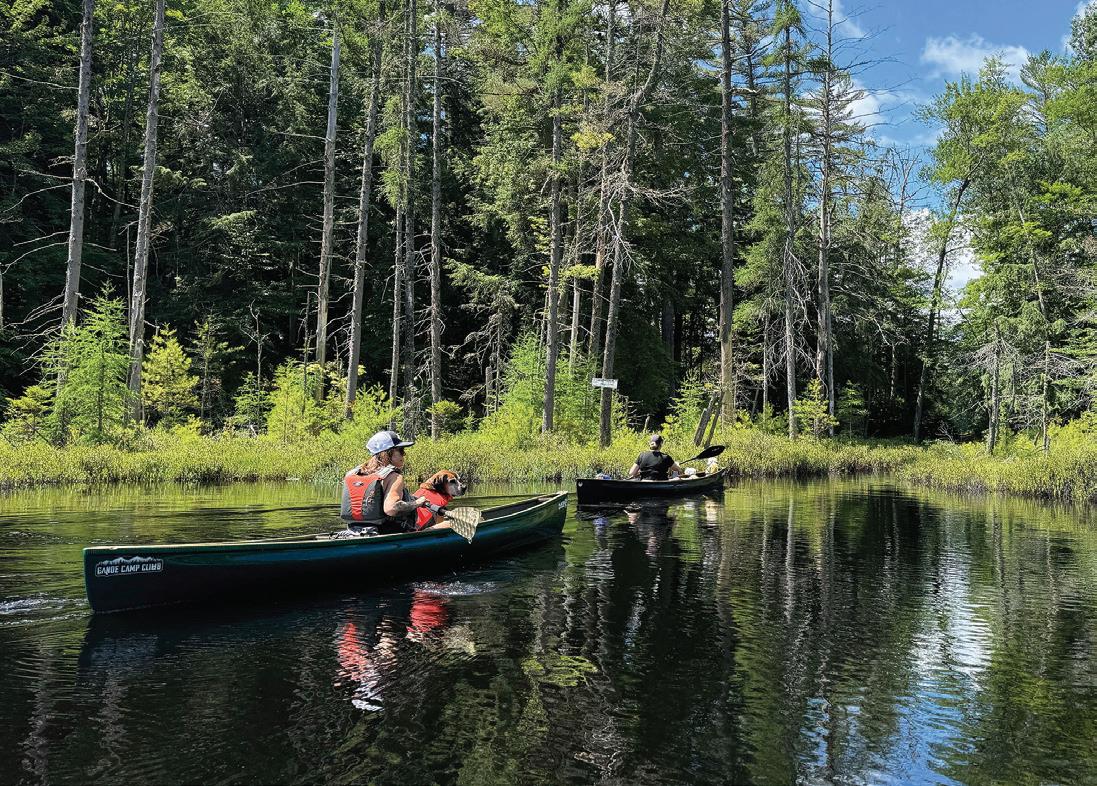


By AMBER ADAMSON
Development and Communications Director at Champlain Area Trails
— Since 2009, a beautiful transformation has occurred in the heart of New York’s Champlain Valley. Born out of a love for nature and a vision for community access to the great outdoors, Champlain Area Trails has become a beacon of adventure and conservation.
Imagine stepping onto a trail where every step forward brings you closer to the natural world. Over 90 miles of winding paths take you through breathtaking scenery, offering panoramic views of Lake Champlain and guiding you through various terrains. This is the world that CATS has gifted to the Champlain Valley’s residents and visitors at no cost — thanks to the many supporters.
CATS’s story is one of enduring commitment to land preservation and community well-being. The organization has protected 992 acres of land, ensuring that this region’s lush landscapes and diverse ecosystems remain a sanctuary for future generations to explore and cherish.
Each trail tells a tale of seasons changing and wildlife roaming free. They are meticulously designed to welcome hikers of all skill levels, from families embarking on their first outdoor excursion to seasoned adventurers seeking new
challenges. Besides their natural beauty, what distinguishes these trails is their charm across all seasons. The late fall to early winter months reveals a special magic as the dense foliage thins to unveil hidden vistas and snow blankets the ground, turning these paths into a winter wonderland. During this time, CATS ensures that everyone can enjoy the frosty beauty by lending snowshoes for winter hikes, so contact their office if you need a pair.
But CATS’s story goes beyond trails and conservation. It is also about building a healthier, happier community.
Recognizing the integral role of nature in enhancing physical and mental well-being, CATS organizes events that bring people together and connect them to the outdoors. From free concerts amidst a quarry to forest bathing sessions that soothe the soul and the “Grand Hike,” a 14-mile odyssey through varied landscapes, CATS crafts experiences that are inclusive and engaging for all, especially encouraging older adults and families to find joy and vitality in nature’s embrace.
Recommended starting points for those new to hiking or seeking gentle trails to enjoy in the cooler months include the serene Wildway Passage Loop Trail in Westport, the picturesque Art Farm Trail in Essex, and the tranquil Riverside Trail in Willsboro.
These trails embody CATS’s mission: to make the outdoors accessible and enjoyable for everyone.
CATS connects people with nature through its work and weaves a community together through shared experiences and a collective appreciation
for the natural world. Whether one is a seasoned hiker or just starting out, CATS offers an open invitation to discover the rich tapestry of landscapes in the Champlain Valley, turning each journey into a story of adventure, connection, and preservation.
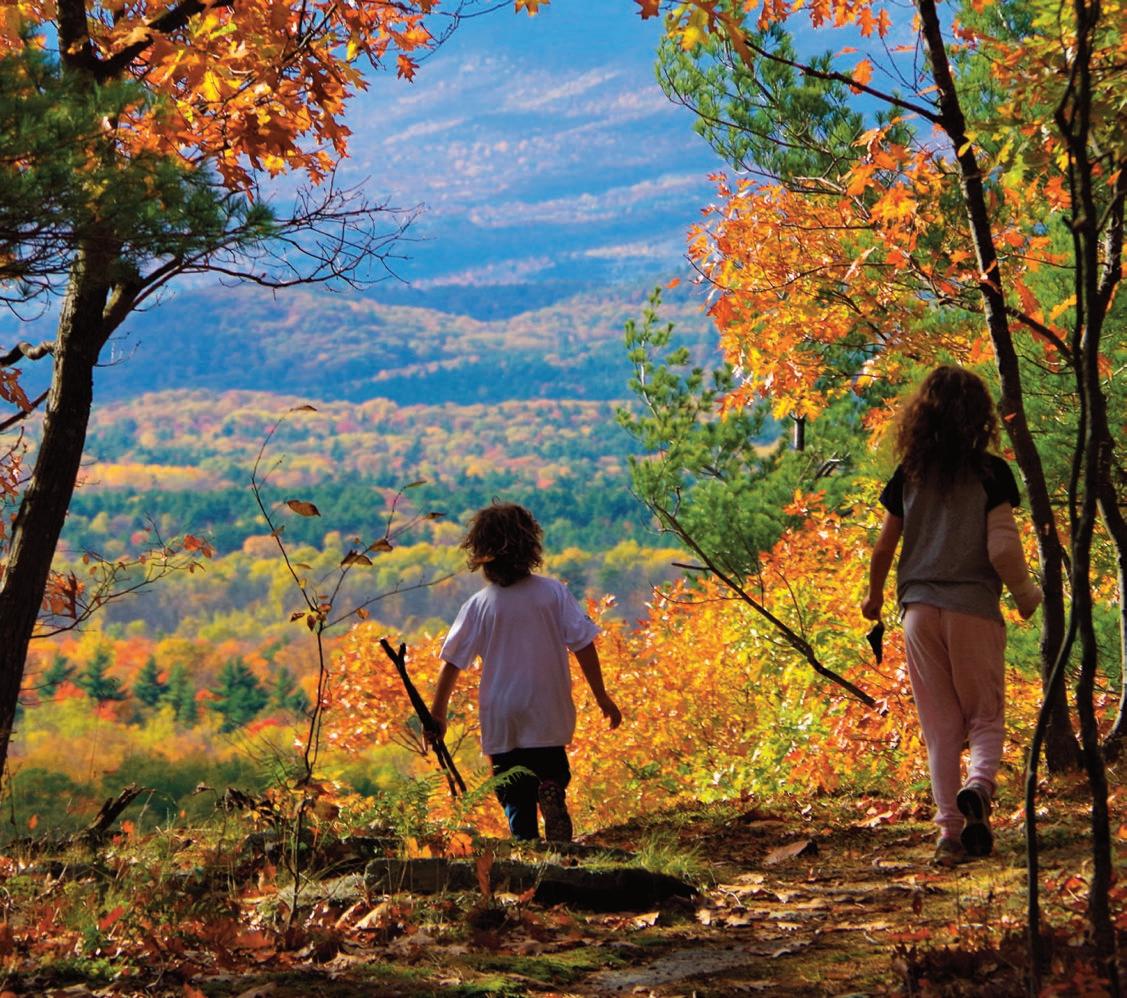
Explore NY’s Champlain Valley
And CATS’ 100 miles of uncrowded, family-friendly trails. For maps of all the trails in the Champlain Valley visit:www.champlainareatrails.com


By NINA SCHOCH
Adirondack Center for Loon Conservation SARANAC LAKE — In late summer, as young loons across the Adirondacks approach fledging age and pairs without chicks explore other waters, many Adirondack lakes begin to host loon social hours.
By mid- to late July, loons that didn’t nest or don’t have any chicks no longer need to defend a breeding territory. Thus, these birds fly around to other lakes to socialize and cooperatively feed with other loons. Loon pairs that do have chicks usually are still very territorial at this time, since intruding loons may try to kill another pair’s chicks in an attempt to oust a member of the breeding pair and take over a territory. However, as the summer comes to a close and chicks gain their independence, parents regain their social lives and also join the social gatherings. The number of loons in one group can swell to 60 birds or more!
There are many excellent Adirondack lakes to observe loon social gatherings, especially the larger ones. Some of these larger lakes are used

.each year by dozens of loons as a “staging lake,” where loons feed and molt into their winter plumage before continuing on to the ocean. In late
September and early October, groups of 30 to 100 loons can be observed preening heavily, communicating with soft hoots, and cooperatively feed-
ing on forage fish such as shiners and yellow perch. These parties seem very well-catered,
in preparation for the long migration ahead.
Research by Dr. Jay Mager of Ohio Northern University and Dr. Jim Paruk of Saint Joseph’s College of Maine, among others, has shown that wintering loons continue to congregate in large groups to cooperatively feed. Interestingly, loons appear to fall into distinct categories of social behavior. Some loons regularly socialize and feed cooperatively on schools of small fish, reducing the overall amount of time they spend feeding. On the other hand, other loons are more solitary and spend significantly longer amounts of time hunting for larger fish than the social birds. Similar to humans, it seems that some introverts would rather avoid the crowds. For more information about loons, please visit our “nest” or website: Adirondack Center for Loon Conservation 75 Main Street, Saranac Lake, NY 12983 (518) 354-8636, info@adkloon.org www.adkloon.org www.facebook.com/ adkloon, www.instagram.com/

¯ A group of loons is called an “asylum.”
¯ Adirondack loons commonly begin to gather in groups starting in mid-July.
¯ Molting into winter plumage usually begins around the same time of the large gatherings (late summer and early fall).
¯ When loons congregate in large groups, they also begin to molt into their winter plumage.
¯ The fall molt typically starts around the mouth, which can sometimes be mistaken for a clump of fishing line.
¯ Be on the lookout for loons with white or gray at the corner of their mouths in the coming weeks.”

Don’t let excess, artifical light obscure our scenic, nighttime views of the cosmos. Together, we can keep light pollution to a minimum and preserve New York’s dark skies for the benefit of people and wildlife.



ALBANY — Small game hunting seasons across New York kicked off on Sept. 1 to March 30, according to the state Department of Environmental Conservation. Depending on species and location, the state offers small game hunting opportunities.
Season dates, bag limits, and other hunting regulations for New York’s small game species are available in the Hunting and Trapping Regulations Guide, which can be obtained from any license-issuing agent or on DEC’s website (https://tinyurl.com/ a7rh77k3).
Squirrel, rabbit, hare
Opportunities to pursue squirrels and rabbits can be found throughout the state, including on many public lands. Squirrel seasons started Sept. 1 in upstate New York and begins Nov. 1 on Long Island.
Rabbit hunting begins Oct. 1 in Upstate New York and on Nov. 1 on Long Island. With ample opportunities and mild weather, squirrel and rabbit hunting are great ways to introduce novices to hunting.
Snowshoe hare (or varying hare) season starts Oct. 1 in the Northern Zone. Hare hunters in the Southern Zone, where the season starts in late fall or early winter, are encouraged to report their observations to the DEC through DEC’s website.
Youth waterfowl, Canada goose Waterfowl seasons in New York begin with a September Canada goose season designed to help manage resident or less migratory local Canada goose populations. The season in upstate New York and eastern Long Island is open from Sept. 1 to 25.
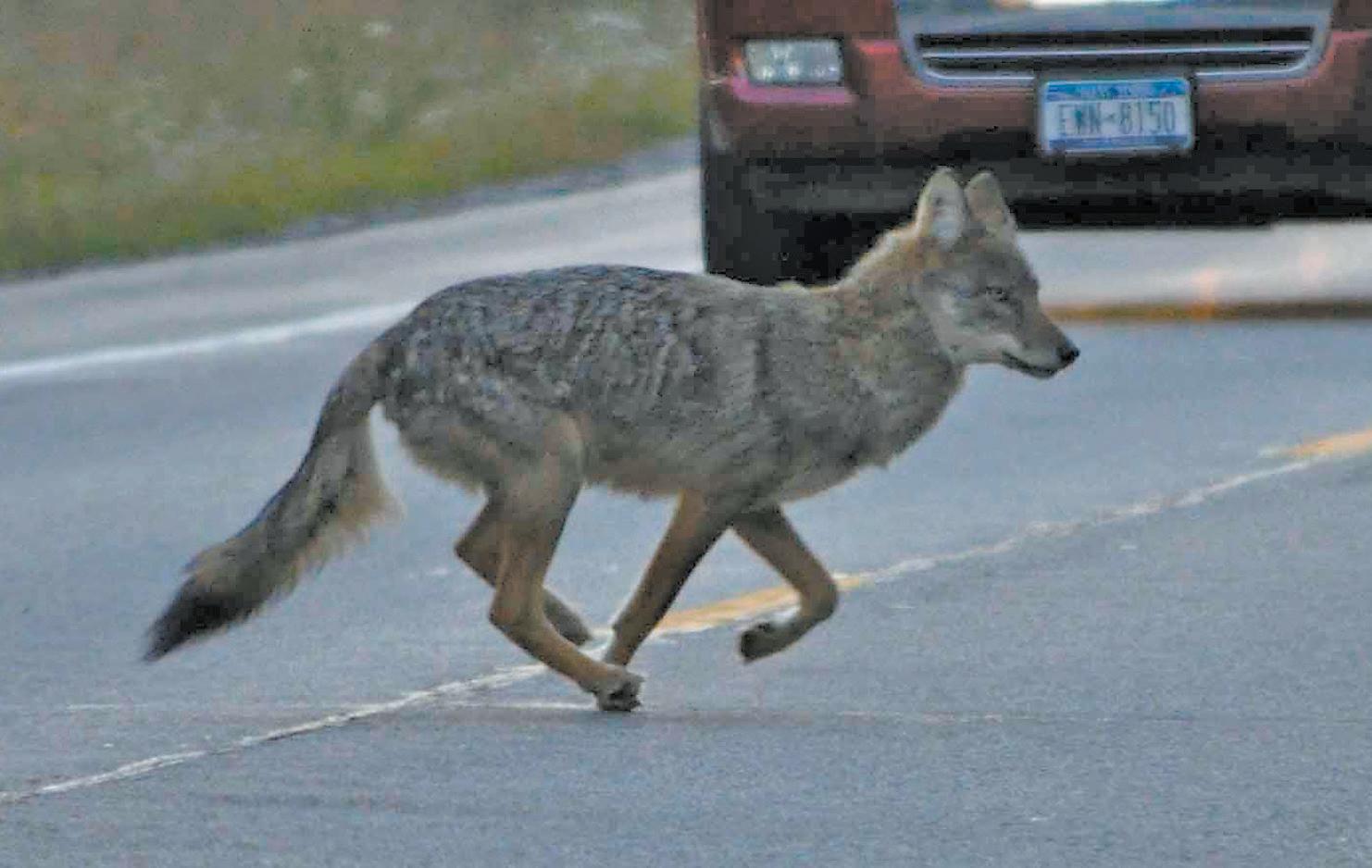
The season closes when migratory Canada geese return to New York at the end of the month.
In addition to September Canada goose seasons, New York also offers youth waterfowl hunting days and Military waterfowl hunting days. Military season dates vary by zone, but the youth waterfowl dates in all upstate zones are the weekend of Saturday, Sept. 28 and 29. On Long Island, the youth dates are Nov. 9 and 10.
Pheasant
DEC has made significant efforts to modify the pheasant propagation program to more effectively recruitment new hunters and to retain or reactivate existing hunters. Changes include:
¯ DEC’s Reynolds Game Farm hatched roughly 13,000 pheasants for cooperators across the state to raise to adulthood and release on public hunting areas;
¯ Improved hunting experiences by increasing the number of stocking locations, targeting areas closer to populated areas, increasing the number of days pheasants are stocked and the number of birds released per day, and releasing birds into December in some upstate regions (avoiding southern zone firearms deer season);
¯ DEC reserved up to 6,000 birds for the Sponsored Hunt Program. Sponsored hunts are free, non-competitive events coordinated by a group, club, individual, or organi-
Continued on page 13
zation to benefit youth, women, first-time hunters, veterans, people with disabilities, and other underrepresented groups. Sponsored hunts can occur any time during the hunting season, not just during special seasons. DEC is still accepting applications from people interested in hosting an event; and
¯ DEC developed a new HuntFishNY registration page for mentored hunting and fishing opportunities. Hunters interested in attending a mentored hunt can find opportunities in their area and register directly through the website for sponsored hunts (https://tinyurl.com/7masfwkv).
An interactive map of statewide pheasant release sites, approximate timing of stocking and number of birds stocked can be found on DEC’s website. If hunters prefer to search based on the property name, region, county or township, they can use the table view. Please note that stocking in some regions extends later into the hunting season. Late season stockings are snow depth-dependent and stocking locations and the number of birds released are subject to change.
Ruffed grouse hunting season runs from Oct. 1 through the last day of February in most parts of the state. In northern New York, the season opens Sept. 20 and runs through the last day of February. In New
York City and on Long Island, the season is closed.
Ruffed grouse hunters in the Northern Zone are reminded to positively identify quarry before shooting. The Northern Zone, specifically Wildlife Management Units 5C, 5F, 6F, and 6J, is also home to the spruce grouse, a state-endangered species that is illegal to hunt. Loss of a single spruce grouse, particularly a female, could be a significant setback for a small local population. For tips on how to discern the two species, view the Hunting and Trapping Regulations Guide or the Ruffed Grouse Hunting Information page on DEC’s website (https://tinyurl.com/3dcxeha7).
DEC encourages ruffed grouse hunters to take part in the grouse hunting log program and submit feathers from harvested birds to assess recruitment (number of young produced per adult female grouse) for different parts of the state. Interested hunters should visit the DEC website to learn more.
With 16 species of furbearers in New York, furbearer hunting and trapping opportunities are abundant. Coyote hunting season begins Oct. 1 across much of the state and hunting seasons for other furbearers such as bobcat, raccoon and fox begin Oct. 25.
As a reminder, hunters that harvest a bobcat in New York must complete a furbearer possession tag and get the pelt or unskinned animal sealed. DEC is also interested in examining coyotes that exceed 50 pounds
as part of an effort to better understand the genetic makeup of these uncommon specimens. Hunters can contact a regional wildlife office or DEC law enforcement (1-844-332-3267) to arrange for DEC to collect a biological sample.
Season dates and zone boundaries for all furbearers can be found on DEC’s website and in the Hunting and Trapping Regulations Guide (https://tinyurl.com/a7rh77k3).
While statistics show hunting in New York is safer than ever, mistakes are made every year. Every hunting-related shooting incident is preventable and DEC’s interim commissioner encourages hunters to use common sense this season and remember what they learned in DEC’s Hunter Education Course:
¯ Point your gun in a safe direction.
¯ Treat every gun as if it were loaded.
¯ Be sure of your target and beyond.
¯ Keep your finger off the trigger until ready to shoot.
In addition to blaze orange or pink being required for hunting big game with firearms, DEC encourages small game hunters to wear blaze orange or blaze pink. Wearing orange or pink makes hunters more visible to other hunters.
For more information and other important safety tips, visit DEC’s website (https:// tinyurl.com/yx2aaxss) and watch videos about hunter safety. For more information, visit DEC’s website (https://dec.ny.gov/).


By AARON MARBONE Staff Writer
WILMINGTON — Wes Poe looked into the camera, flashed a thumbs-up, said “Sept. 8th” and took off on his skis across extremely thin snow cover on the deck at the summit of Whiteface Mountain.
On Sunday, Sept. 8, Poe, Brayden Olden, Brenna Towne and Sasha Baker — all 20and 21-year old students at SUNY Plattsburgh — set out at 2 a.m. to get first tracks of the season at the mountain.
“My friends and I are always watching the weather,” Poe said.
They saw the National Weather Service had a snowflake icon on the Whiteface summit prediction for Sept. 8. They decided to go check it out.
“It was so freaking worth it,” Poe said.
There wasn’t enough powder to ski the toll road — the Whiteface Veterans Memorial Highway — but they were still likely the first people to get their turns in on the mountain, which holds the ski center.
“You never know,” Poe said. “But Sept. 8, man.”
For years now, backcountry skiers have traveled to the toll road to ski before there’s enough snow to ski other favorite spots and well before the ski lifts further down the mountain open.
“The eastern skier is something else. We embrace that,” Poe said. “Out west ... you

can get it out there in the Rockies in August and September. It’s not uncommon. But here, it’s nuts.”
Part of the draw is the novelty — doing the stuff that most people don’t want to do, or don’t think about doing. The other part is a love of the sport.
“Skiing’s just awesome,” Poe said. “When it’s summertime and you’re dripping sweat outside, all I’m thinking about is when those first flakes are going to fall.”
Their skis don’t spend a lot of time in the closet.
On June 4, just around three months ago, Poe, Olden and Andrew Ramsey hiked their gear up to Mount Marcy to ski a long patch of snow hanging on in the blazing sun. They got some weird looks on their way in.
“We know it gets filled in in the winter and it takes a while to melt in some of these deeper pockets,” Poe said.
Continued on page 15
He said it felt incredible to chase those conditions this early in New York.
“People are still playing golf, trying to get out the last beach days, and here we are, nutcases heading up there,” he said.
The heat doesn’t please him. While on the summit, with the clouds choking out the sun, the wind whipping about and the air frigid, he said he turned to Towne and said “This is awesome.” This group has sought first turns for the past three years.
Poe said they were inspired by the legendary “Ron Kon.”
“I want to shout out Ron Konowitz. That guy is freaking nuts. I love him,” he said.
Konowitz actually had his gear ready to go on Sunday, but decided there wasn’t enough snow for him to do the toll road. He said he admires what the Plattsburgh crew did. There wasn’t a lot of snow but he commended them for being creative.
For decades, Konowitz has been skiing the Whiteface toll road earlier in the season than most would expect.
“I’ve always loved winter and I’ve always loved skiing,” Konowitz said.
He said these early treks are his “temporary winter fix” which can only be found at high elevations. He started in the 1970s but he’s sure people were doing it before that.
“I’m sure there were diehard skiers who were getting early tracks. I don’t remember ever hearing about that. But then again, we didn’t have internet,” he said.
For years, Konowitz’s annual sojourn was under the radar. He had a reputation among his friends and local skiers
for going up early. But one year, after he got a Facebook account, he posted about it and within a couple of hours 350,000 people had seen it.
The next day he went back to ski and was shocked to see a slew of cars with people traveling from all over to see the crazy Adirondack road skier.
The earliest Konowitz has ever skied there was on a Labor Day weekend.
“Back in the ’90s and ’80s we used to get a lot more snow,” he said.
Over the years, the first turns day has been shifting further toward the fall. Sunday was an outlier.
Last year, when Konowitz went to ski the toll road on Oct. 22, he said Poe and Olden beat him by an hour.
“I don’t know if I’ll ever get first tracks again,” Konowitz said.
Of course, there’s a friendly competitiveness to it. These ski enthusiasts want those bragging rights to the first tracks. But the goal is really about the adventure of getting out and seeking winter as early as possible.
“They’re young and they’re enthusiastic and they’re excellent skiers,” Konowitz said of the Plattsburgh students.
He said they’re “park rats” — in a good way.
The push to ski early is a positive activity, he said.
“It takes discipline and motivation and a love of the sport,” he said.
Seeking first or early turns is not for everybody, though, Konowitz said. Skiing the toll road with light cover means the pavement is a “no-fall zone.”
Poe said this group skis as often as they can in the traditional season, too.
“I’m just waiting for more now,” Poe said. Continued from page 14

General emergencies: Call 911 Backcountry emergencies: 518-891-0235
The New York State Department of Environmental Conservation operates a dispatch center at the DEC Region 5 office in Ray Brook 24 hours a day, 7 days a week. It should only be contacted to report backcountry emergencies (lost or injured people and wildfires).
Non-emergencies: The New York State Police Troop B, 518-897-2000, Clinton, Franklin, Essex, St. Lawrence, Hamilton counties; Troop D, 315-3666000, Lewis, Herkimer, Oneida, counties; Troop G, 518-783-3211, Fulton, Hamilton, Saratoga, Warren, Washington counties.


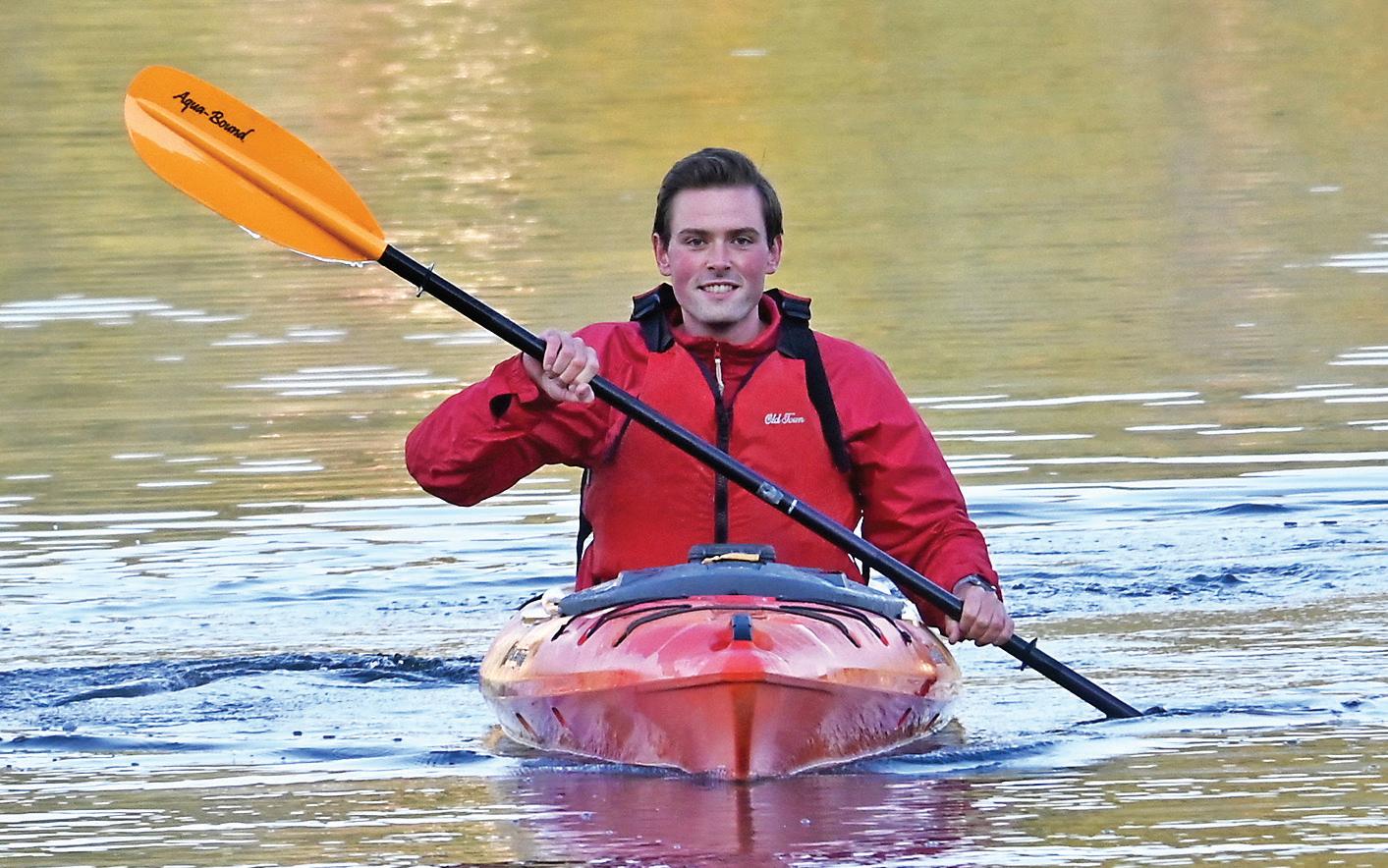
By CHRIS GAIGE Staff Writer
LAKE PLACID — As its name suggests, Mirror Lake should be smooth as glass. While theory doesn’t always match with reality, the lake sure lived up to its name around daybreak on Wednesday, Sept. 11.
As the planets and stars slowly drifted away in the salmon skies above, there was not but a single ripple on the lake as I began my sunrise paddle. This scene stood in stark contrast to the angry chop on Fish Creek Ponds that I watched from shore just three days before.
Last week, I had the honor of participating in the 90-Miler canoe race from Old Forge to Saranac Lake. Unfortunately, high winds forced the cancellation of the third day. The course on that day of the race crosses directly through the three Saranac Lakes: Upper, Middle and Lower. Their monstrous size, just under a combined 9,000 acres, and vast stretches of open water meant that whatever froth I saw on the small ponds that fed into Upper Saranac Lake would have been magnitudes mightier just a few miles away. There was much anticipation and uncertainty as to what race officials would announce at the morning paddler’s meeting.
A sweeping cold front swept across the Adirondacks the night before, plunging air temperatures into the mid-40s that morning. The cold was ushered in on winds forecasted to peak later that morning at around 20 miles per hour, with gusts as high as 35

mph.
At 7:30 a.m., with the first boats set to launch in just half an hour, race officials took to their bullhorn to announce that, after assessing conditions with forest rangers assisting race safety and logistics, the day had been called off due to dangerous conditions between the winds and temperatures. While some folks were undoubtedly and
understandably disappointed to be robbed of the final 20-something miles of paddling, I managed to, off the record, of course, take the cancellation call in stride. Weather aside, my masked jubilance perhaps had something to do with my arms feeling as if they were about to fall off from
Continued on page 17
paddling 63 miles the last two days.
In any event, after some much-needed rest and recovery over a few days away from the water, I resolved to get back in a boat and keep on paddling. Someone check my sanity.
In total, 25 miles were missed on Day 3. Should I have made that up, I thought? I was quick to not get too carried away with myself. After some deliberation, I slid the decimal point, and voila: 2.5 miles, on the other hand, that sounded better.
Mirror Lake
Mirror Lake provides an ideal setting for any paddler, whether they are experienced or stepping in a boat for the first time.
Weather conditions appeared optimal for a sunrise paddle on Wednesday. I (carefully) jumped into my personal kayak, a Wilderness Systems Pungo 120, and put in around 6:30 a.m. I began my paddle on the north end of Mirror Lake as the fog was beginning to
lift. I set off in a counterclockwise direction hugging the shoreline.
Day-breaking scenes of Mount Whitney and Cobble Hill first greeted me. Soon thereafter, magnificent views of the High Peaks began to open up. In my humble opinion, the northwestern edge of Mirror Lake provides one of the most iconic views anywhere in the Adirondacks. Upwards of a dozen High Peaks, including Mount Marcy and Algonquin Peak, the tallest and second tallest mountains in the state, respectively, can be seen in their full glory from the water. Some of you reading this probably have that image in your head right now.
Many of Lake Placid’s most opulent and historic buildings can be seen in a unique manner from the water. Continuing my paddle, I passed by Mid’s Park and the rest of the downtown stretch. I reached the approximate halfway point of my paddle at the town beach just as the sun poked its rays above the Sentinel Range to the east.
Still early, it was striking
Continued on page 18


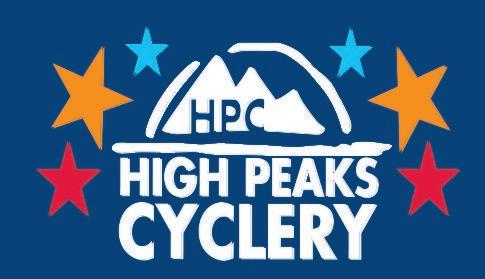











to feel the tranquility of the moment. Despite being so close to one of the busiest areas in the Adirondacks, there was silence and stillness on the water. The roads were nearly empty and only a handful of the dedicated joggers made their way around the shore.
Looking back, plumes of fog lifted to the north over Lake Placid, providing occasional glimpses of Whiteface Mountain through the clouds as the sun continued to grow. I was reminded that while still on the water, the landscape around me was rearing up for another autumn day.
Continuing along Mirror Lake’s eastern shore, it was a relief to no longer have the sun in my eyes. Looking back at Lake Placid from a distance was also unique in its own way, and seeing the center of the
village in one glimpse served as a pleasant reminder of the quaintness many come to Lake Placid seeking.
Before long, I had made my way around the lake, and my paddle concluded. You could paddle Mirror Lake a hundred times and come away with a hundred different scenes, experiences and memories. The column thus far would have been an entirely different experience had I gotten in the boat hours later. Not better, not worse, but uniquely different. That’s the beauty of paddling and a good incentive to keep at it, at least on Mirror Lake.
Of course, just as there is no such thing as a best time to paddle, there is no set route on the lake. It’s not a road and it’s not a trail. You chart your own course. While I chose to make my way around, the more sane amongst us might just float out to the middle of the lake, lounge around and soak in some sun-
shine, before paddling back to where they put their boat in.
Lake access
There are two public access points to Mirror Lake. One is just below the tennis courts near the Mirror Lake Public Beach. Putting boats in there is encouraged, as the beach itself, at least during the warmer months, is frequented by swimmers and can be congested. Boaters transporting their own vessels should take care while unloading along Mirror Lake and Parkside drives, as the roads are often busy.
The other location is along the lake’s north shore. A state Department of Environmental Conservation sign marks the parking lot on the north side of Mirror Lake Drive. Parking is free for 24 hours and there are public restrooms adjacent to the lot. Boaters must take care while crossing Mirror Lake Drive to access the carry path

into Mirror Lake, as there is no marked crosswalk between the parking lot and the carry. Vehicles have the right of way here. After crossing the road, the carry to Mirror Lake is flat and brief, only 100 yards as measured by my GPS watch. A dock extending into the lake allows boaters to avoid any mud and put their boats directly into open water.
When getting into a boat off of a dock, people should take care to get in their boats slowly to maintain stability. When in a boat, the lower your center of gravity is, the more stable you are. And, especially if one is less experienced, they should have a plan if they do fall to throw themselves away from the dock and boat, so as not to hit their heads on either of the two. Ideally, you should paddle with a partner or a group to minimize risk in a situation like this.
In terms of general safety, boaters should always wear a personal floatation device, commonly referred to as a “lifejacket.” This holds true for everyone. Let me repeat that. This holds true for everyone. Common sense is not so common.
Legally speaking, in New York you are required to have one PFD per person in or own your boat. The PFD must fit the person, be readily accessible, and be free of any damage or tears. Children under 12 must always wear a PFD while boating. Everyone, regardless of age, must always wear a PFD while boating between November 1 and May 1.
PFDs save lives. If you are not legally required to wear one and are considering whether or not to, you should be especially mindful of the enhanced dangers presented by high boat traffic, cold weather, severe weather, rough waters, nighttime boating, poor swimming skills and situations where rescue assistance is unavailable or would take a while to reach your boat.
On the point of high boat traffic, fortunately for paddlers, Mirror Lake is off-limits to gas-powered engines. While boats with electric motors are allowed, they cannot exceed

Continued from page 18
7.5 horsepower. Not only does this help to keep Mirror Lake clean, but this is a huge relief for paddlers and peddle-boat operators, who frequently have to contend with blazing-fast motorboats that can come obnoxiously close, throwing off large wakes that can capsize canoes and kayaks.
This alone makes Mirror Lake a great choice for anyone looking to get out on the water in a canoe, kayak, paddleboard, pedal boat or water bike. If you don’t have your own, a number of businesses in and around the community of Lake Placid offer rentals. Some are even located on Mirror Lake or will transport the boat directly to the lake’s shore for you.
Mirror Lake also hosts the swimming portion of the Ironman Lake Placid each summer and is a popular spot for long-distance swimming during the warmer months. Just as paddlers despise larger faster boats getting close to us, the same feeling, quite justifiably, holds true for swimmers in Mirror Lake when boaters get too close to them. If you’re in a boat,
even a pedal boat, you’re probably going faster than swimmers. Always remain vigilant and ensure you’re not getting too close to them or blocking their path. There is a swimming lane down the middle of Mirror Lake marked by lines of buoys on either side. When boating near the lane, be especially mindful of this.
If you are staying at a hotel in town, ask if they provide any boating options on Mirror Lake as part of your stay. Some are located directly on the lake, and some have private beaches on the lake, even if the hotel itself is away from the lake.
Boaters should also take care to secure any personal items before heading out. Garbage should never be left in the water. Always make a plan to contain it and carry it out. Cell phones and devices or materials that could be damaged by water or sink should be secured in a waterproof and buoyant compartment of sorts.
Boaters should, of course, check the weather and pay attention to the wind before heading out. Another perk of Mirror Lake is that being relatively small,
128 acres to be precise, the lake usually does not become too choppy. However, on blustery days, waves on Mirror Lake could capsize canoes or kayaks, especially for those with less experience or who are in narrow boats that could tip over more easily. Know yourself and your boat, and plan ahead for this. In general, winds tend to be strongest in the afternoons. This can make sunrise or evening paddles an enticing option. Mirror Lake is also less busy at those times for folks looking for a quieter experience on the water. If there is a wind, boaters should also be prepared for a
headwind on their return. In other words, it’s easy to ride with the breeze, but make sure you can paddle against it when you have to turn back to where you began your paddle. This is especially true for paddleboards, pedal boats and water bikes, which tend to provide less speed efficiency than canoes and kayaks. Nobody ever said the laws of physics are fair.
No matter which of these boats you set off in, paddling or hydropedaling Mirror Lake is a must for anyone visiting Lake Placid who enjoys time out on the water.

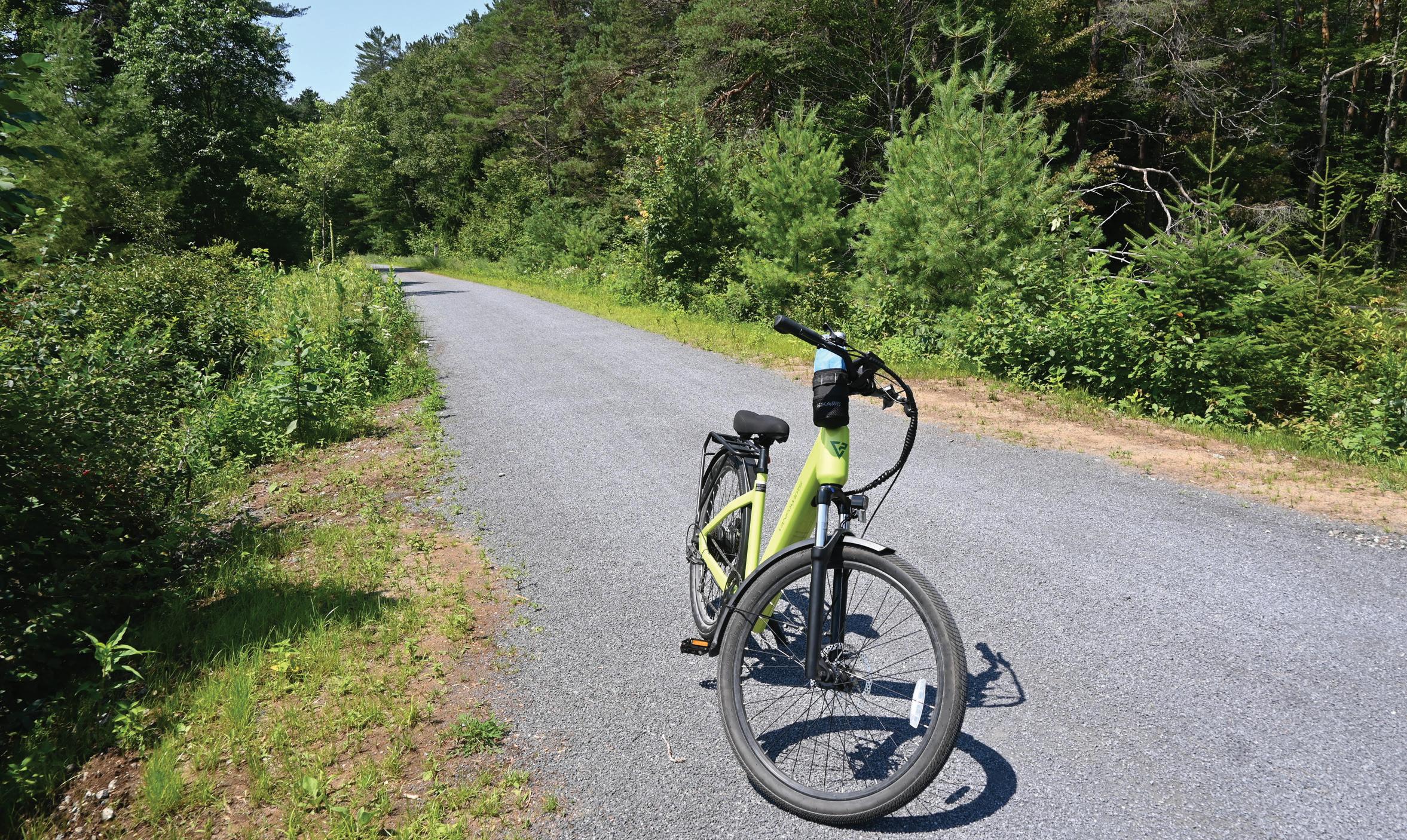
By DELAINEY MUSCATO
Lake Placid News Intern
LAKE PLACID — Under a bright sun and through a gentle breeze on Tuesday, July 16, I took an e-bike on the Adirondack Rail Trail for the first time.
I started on the trail in Lake Placid, near the Lake Placid-North Elba Historical Society’s museum at the old train station on Station Street. Having never ridden an electric bike before, I wasn’t quite sure how far I would end up going on the trail. I found myself at Fowler’s Crossing, state Route 86, in Saranac Lake before long.
The trail to Saranac Lake was beautiful.
A relaxing bike ride through the woods kicked my morning off in just the right way. I was shocked by how immersive the trail was. Even after driving past trail entrances for weeks, I had no clue about the natural beauty hidden along the rail trail.
The trail features different flora and fauna on both sides.
Chipmunks, frogs and butterflies raced across the trail
Continued on page 21
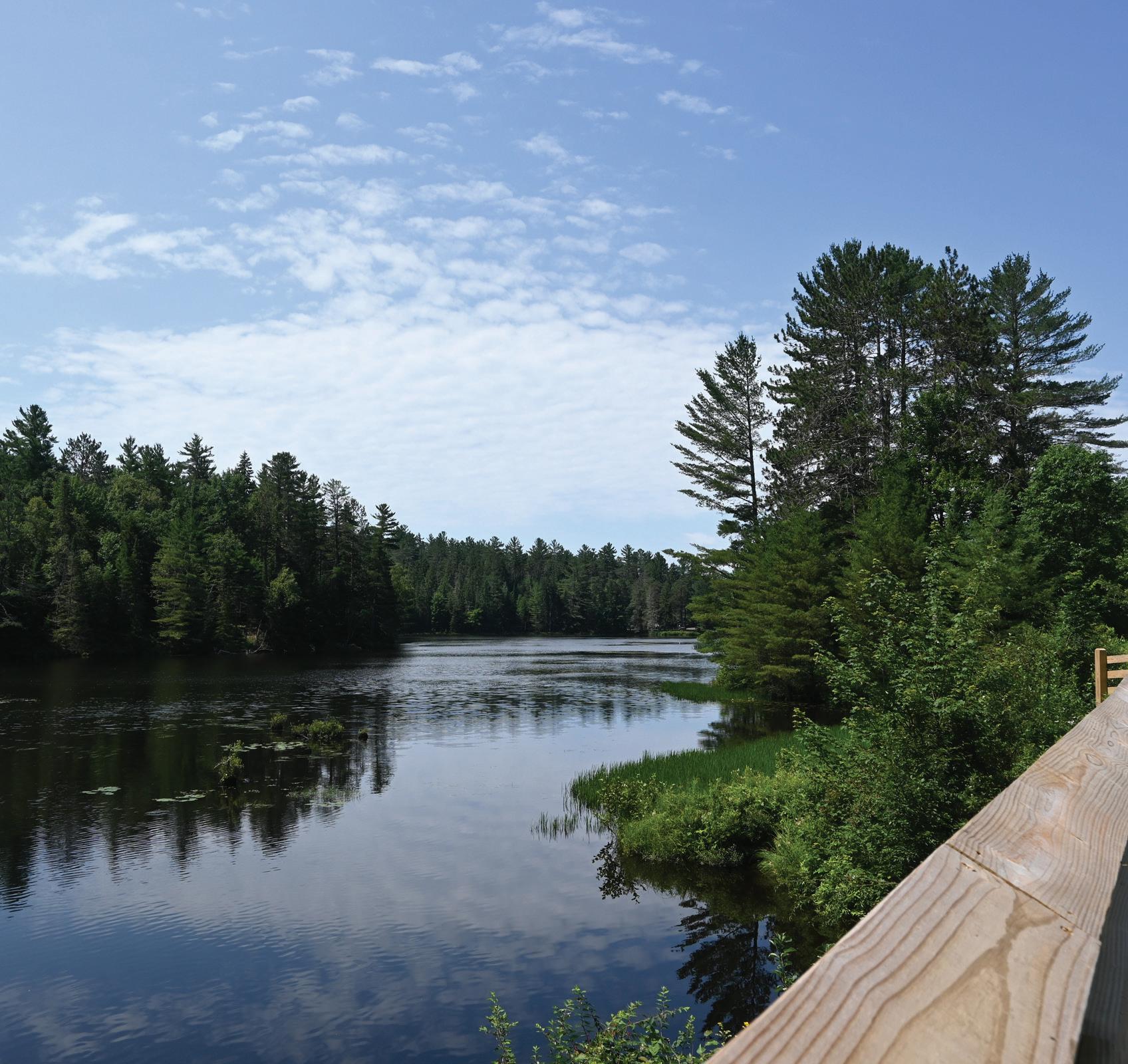
in front of me, often narrowly avoiding the front tire of my e-bike.
Karen Delaney, co-owner of High Peaks Cyclery, suggested I keep my eyes peeled for any otters in or near the water along the trail. Unfortunately, I did not see any of these cuddly creatures.
I do not often go for walks or bike rides without an accompanying soundtrack, but this time I challenged myself to leave my headphones in the car and listen to the music of nature. I am so thankful I did.
The trail sounded so peaceful. Birds chirping, frogs croaking and even fish jumping kept me more than entertained throughout my whole ride.
My favorite part of the trail was by far the pond just before you reach the trail entrance at North Country Community College. Bright white water lilies and light green lily pads cover the pond.
Another aspect of the trail that shocked me was its cleanliness. I don’t think I saw one piece of trash. The care people have for this trail is evident. And almost everyone I passed on the trail, whether on bike or on foot, waved or said hello.
As a first-time e-bike user, I can say the trail was a great place to try it out. Though not entirely paved, the trail rides smoothly and allows you to pick up a good amount of speed. I got up to 26 mph on a downhill section of the trail.
The scariest part of the trail was crossing the road, but not because of the cars zipping by. Every time I had to cross, I was terrified I would crash into the yellow gates marking the gap in the trail. Delaney said a friend of hers once ran into the gates, causing her to crash into her friend. Luckily, I made it through each gate unscathed.
Construction on the 10-mile section of the Adirondack Rail Trail — Phase 1 — from Lake Placid to Saranac Lake began on Nov. 2, 2022, and it was officially opened on Dec. 1, 2023. Phase 2 — from Saranac Lake to Floodwood Road — is currently under construction and is expected to be finished this fall. Phase 3 — from Floodwood Road to Tupper Lake — is expected to be complete by the fall of 2025.

Then then entire 34-mile trail will be open.
Though I rode the trail alone this time, I would love to ride it again with a buddy. The silent reflection time, however, was really nice.
I want to extend a huge thank you to High Peaks Cyclery in Lake Placid for providing me with a bike, helmet and trail information.
There are three bike shops, not too far from the beginning of the trail in Lake Placid, to rent bikes.
Bike Lake Placid is just outside the start of the trail, near the firehouse, at 455 Old Military Road.
High Peaks Cyclery is 1 mile from the trailhead at 2733 Main St.
Placid Planet Bicycles is 1.5 miles from the trail at 2242 Saranac Ave.
Only class 1 e-bikes are allowed on the rail trail.
For more information, visit the Adirondack Rail Trail Association’s website at adirondackrailtrail.org or the rail trail’s page on the state Department of Environmental Conservation website at dec. ny.gov/places/adirondack-railtrail.


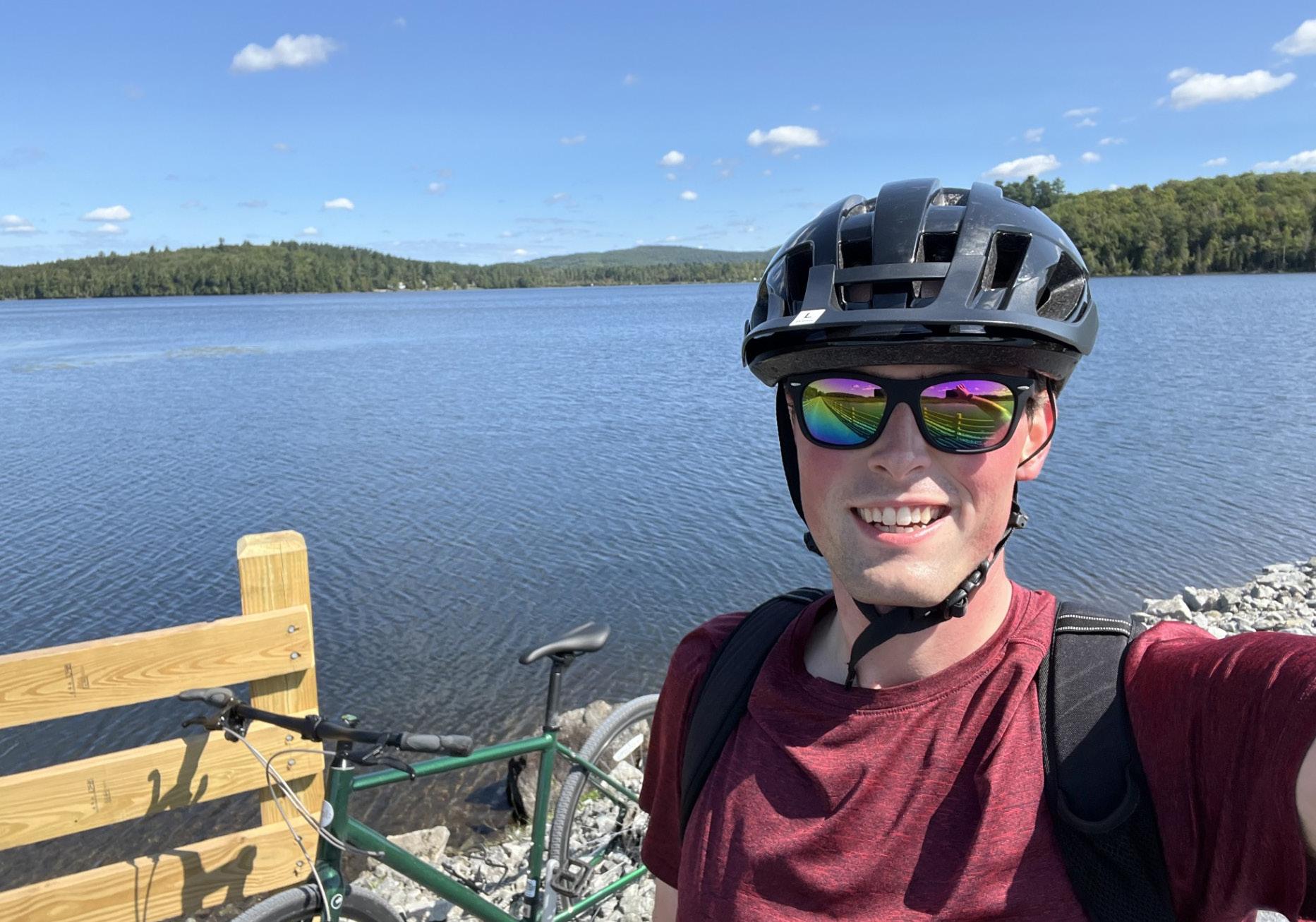
By CHRIS GAIGE Staff Writer
SARANAC LAKE — I have never been on a seaplane before. My imagination wandered as I glided down the causeway over Lake Colby along the newly completed section of the Adirondack Rail Trail on a bicycle. Glancing off to the side, tree branches gave way to beautiful blue open water just feet off the smooth gravel trail. It was as if I was on final approach to landing a twin-engine.
Just last week, New York opened the latest stretch of the Adirondack Rail Trail. The 15-mile section begins at the Saranac Lake Union Depot and extends west to Floodwood Road, about 9 miles north of Tupper Lake.
It is part of a three-phase construction process that will eventually yield a 34-mile rail trail from Lake Placid to Tupper Lake. Construction on the final Floodwood to Tupper Lake stretch began in August, while the 10-mile Lake Placid to Saranac Lake section opened last December. This allows users continuous access from Lake Placid train station to Floodwood Road — 25 miles in total.
While the trail crosses roads at various points, no motor vehicles are allowed on it, save for snowmobilers who use the trail in the winter months. This makes for not only a
more tranquil ride but a safer one as well. I had the privilege of touring about half of the new section of trail — on wheels.
My first stop was at the High Peaks Cyclery in Lake Placid. There, I was greeted by Derrek Russell and Timothy Ziegler, who fitted me on the spot for the right bicycle and helmet. Ziegler had just completed the new section the night before and was able to answer all of my questions as someone who had never been on the rail trail before and had not stepped on a bike in months.
Between completing the rental forms, learning a bit about the trail, testing out the rental bike in the parking lot and carefully getting it into my Jeep Cherokee, I was on my way in less than 15 minutes. The service could not have been friendlier.
A beautiful 20-minute drive from Lake Placid on Tuesday, Sept. 3 took me to the start of the new phase at the historic Union Depot in Saranac Lake. Once I had my helmet, shades and sunscreen set, it was time to hit the trail!
Traveling out of Saranac Lake at a leisurely pace, I could not help but notice people of all different physical and skill levels were enjoying the trail. There were cyclists in aerodynamic racing outfits cruising along and people like me in T-shirts and shorts taking their time. There were joggers, walkers, strollers and plenty of canine companions,
all on leashes and not one bit of their “business” along the trail.
Given that the trail is a former train track, its grade is very gentle and is especially accommodating for those new to cycling or those traveling by foot looking for a flatter trail option.
Trail users are greeted with their first real treat of this section approximately 1 mile west of the Union Depot. Here, the trail crosses Lake Colby on a causeway, offering wide-open and stunning views of the lake’s largely undisturbed shoreline. I was fortunate to have abundant sunshine for my ride, making the lake a truly brilliant pool of blue.
After stopping to admire the scene, I continued onward. Lush forests and pristine wetlands on either side of the trail offered a truly wild Adirondack feeling, even as I was just minutes from the community of Saranac Lake.
A gentle breeze through the leaves and the soft roll of my tires over the finely crushed gravel blocked out even the slightest inkling of human noise. It was pure bliss. The miles on my GPS-equipped watch began piling up and before I knew it, I was almost at my turnaround point for the day at Lake Clear.
The rail trail soon crossed state Route 186,
Continued from page 22
a “busy” highway by Adirondack standards. The crossing was clearly marked in advance, with one sign about 150 feet (don’t quote me on that, I’m terrible at visualizing distances) in advance of the intersection reminding trail users to stop ahead. The intersection itself has two heavy metal gates that block about half of the trail on the sides.
Not only does this force trail users to slow down, but its bright yellow paint serves as a clear visual for the trail intersection and prevents motor vehicles from entering the trail. All road intersections I encountered on the ride (six, if memory serves me correctly) had these same features, making them easy to identify.
The crossing provides me the perfect opportunity to give you, dear reader, a very important safety lecture.
It is important for trail users to remember the rules of crosswalks. All trail users are required to stop at the crosswalk and look both ways before continuing. People riding a bicycle or snowmobile do not have the right of
way to vehicles, unless they are afoot. In other words, vehicles are not required to stop for them.
Pedestrians, including people walking their bikes across the road, do have the right of way in crosswalks, according to New York state law, and vehicles are required to stop for them.
For pedestrians’ right of way in crosswalks, the state law is clear: “When traffic-control signals are not in place or not in operation the driver of a vehicle shall yield the right of way, slowing down or stopping if need be to so yield, to a pedestrian crossing the roadway within a crosswalk on the roadway upon which the vehicle is traveling, except that any pedestrian crossing a roadway at a point where a pedestrian tunnel or overpass has been provided shall yield the right of way to all vehicles.”
While people are not required to walk their bicycle across the crosswalk unless noted, they must remember that vehicles have the right of way if they choose to remain on their bicycle, unless they are also afoot.
Back to the ride.
After safely navigating the
Continued on page 24

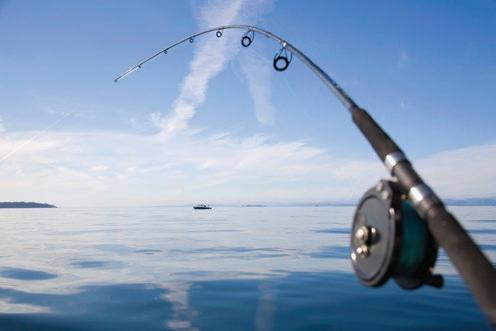

High Peaks Adventure Cycling
Dirt Camps, Bikepacking, Bicycle Touring, Mountain Biking, Lake Placid to Tupper Lake Rail Trail Tours
Shuttles, Tours, Guides, Lessons, Support Multi Adventure Days with Bike, Hike, Paddle, Overnight Trips, Private, Group, Clubs, Family, Schools
Brian Delaney
High Peaks Cyclery
High Peaks Adirondack Outfitters
Fly Fishing
High Peaks Mountain Guides
“True to Our Roots” Since 1983

(518) 523-3764
www.highpeakscyclery.com
2733 Main St., Lake Placid, NY 12946
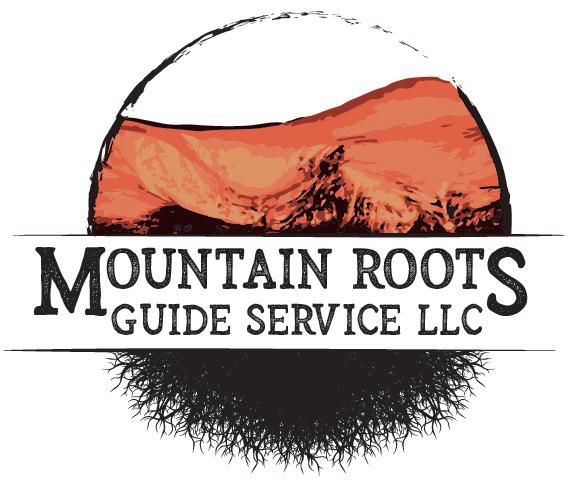
Having spent my life in the outdoors, there is nothing more enjoyable than spending time in nature with others. Mountain Roots Guide Service provides guiding for fishing, ice fishing, hunting and other outdoor activities that you want to enjoy. Let's make memories that will last a lifetime!
Mountain Roots Guide Service LLC- Managing Member: Kelly Starkweather
603-455-2416
5812 NYS Rte 86 • Wilmington, NY mountainrootsguideservice@gmail.com
High Peaks Adirondack Outfitters
Fishing (3 Tracker Bass Boats) Fly Fishing, Spin Fishing, Guide Service, Rentals, Shuttles, Sales, Lessons, Canoe Trips
Sage, Rio, Patagonia, Hardy, Fenwick, Cortland, Wenonah Canoes and more
Experience Adirondack Fly Fishing and Small Pond Brook Trout Fishing
Brian Delaney
High Peaks Cyclery
High Peaks Adirondack Outfitters
Fly Fishing
High Peaks Mountain Guides
“True to Our Roots” Since 1983

(518) 523-3764
www.highpeakscyclery.com
2733 Main St., Lake Placid, NY 12946
intersection, I soon passed by Charlie’s Inn. Their sign just off the trail was easy to spot and promised “Good Food & Good Fun.” While I was unable to personally sample the establishment, as they were closed at the time (my Tuesday ride unfortunately did not align with their Wednesday through Sunday opening), I am inclined to take them at their word. After all, they’ve been providing that food and fun since the early 1890s, when the railroad was originally built.
Soon after Charlie’s, the trail reached the shores of Lake Clear. While a lot of the lake was partially veiled by a thin patch of woods between the trail and the water, occasional clearings provided photo-worthy glimpses of the lake.
I will take the moment to remind the faithful readers who have stuck with me this far to respect private property along the trail, and not venture on to it in pursuit of the pic. Staying on the trail still provides plentiful opportunity for the camera lens.
Back to the ride. Again. While I wish I had been able to complete the rest of the new section, this column wasn’t going to write itself and I was short on time. OK, who I am kidding? That’s just the best excuse I could muster for being exhausted from my first ride in months. Fortunately, with no steep hills to worry about, the ride back was manageable.
It was striking how different the scenes were going in the opposite direction. Even though it was the same path I was just on, it felt like two rides in one. The return trip offered excellent views of McKenzie Mountain to the east and all of its false summits. I can hear the groans of anyone who’s climbed

the peak reading this.
In concluding my ride, I was struck by the fact that in nearly 15 miles of riding, I did not see a single, not one, piece of garbage along the trail. Let’s all do our part to keep it that way, granted the trail opened just last week.
After getting the bicycle back in my car, I made the return drive to HPC and dropped off the rental bike. I was once again met with great service from Ziegler and Russell, who had me on my way in just a few minutes.
The Adirondack Rail Trail makes for a phenomenal way to spend a day or even just a couple of hours. I thoroughly enjoyed my experience on wheels, but the trail is just as accommodating for walkers. If you don’t have a bike on your visit, HPC and other outfitters throughout the Olympic Region have you covered.
Visit https://www.adirondackrailtrail.org or https://dec.ny.gov/places/adirondack-railtrail for more information, including trail maps, parking options and trail rules.










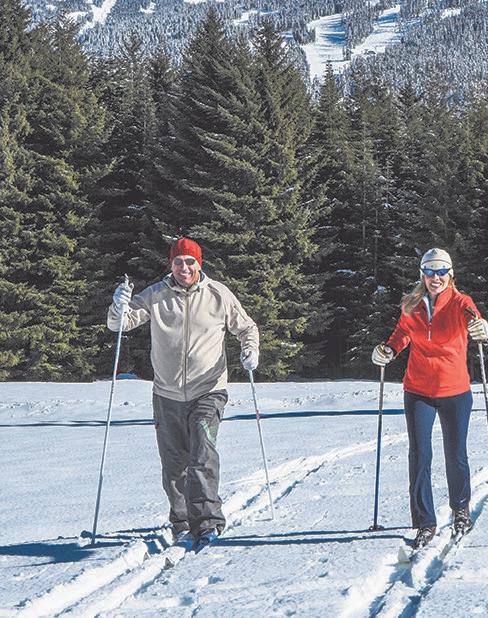



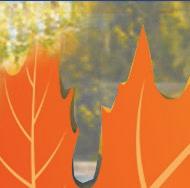
GET READY FOR WINTER! WEEKENDHOLIDAYSALES COLUMBUS THANKSGIVING NEW WINTER GEAR ARRIVING DAILY!




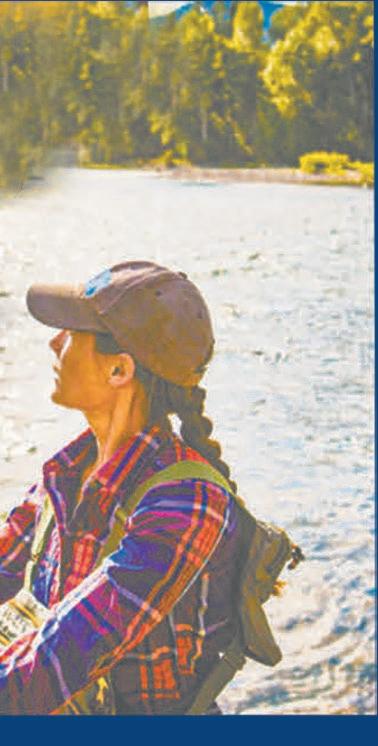
alpine tour yoga y sh nordic ski road bike
e-bikes ADVENTURE mt. bike rock climb
Gravel Ride hike snowshoe lodging fat bike rentals massage guide service
Mountain Adventure Center shuttles


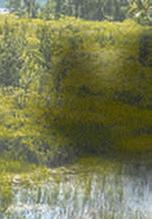

HIKING & SKIING HEADQUARTERS!
Rock Climbing, Hiking, Paddling, Mt. Biking, Gravel Rides
Winter boots & MSR Snowshoes
Black Diamond • Leki • Lowa • La Sportiva
Salomon • Asolo • Oboz • Scarpa
DPS • Icelantic • Scott • Swix










